Frontiers of Modern Astronomy
IMPORTANT UPDATE - 11th Feb 2009
We will not be offering our distance learning courses from October 2009. We are currently exploring alternative ways in which at least some of our courses may be made available, perhaps in collaboration with other universities. Please check with us by email on jodrell.courses@manchester.ac.uk for updates on the situation. The only course still available under current arrangements is the Introduction to Radio Astronomy beginning Feb 16th 2009.
Introduction
| Facts at a glance | |
| Duration | 24 weeks |
| Start dates | 2008 Oct 13th (Oct each year) |
| Cost (2008/09) | £209 (EU) |
| £363 (non-EU) | |
| Level | 2 |
| Credits | 20 |
This part-time course has been developed by professional astronomers
at the Jodrell Bank Observatory and aims to provide students with
up-to-date knowledge concerning several topics of current astronomical
research. Currently these are:
Stellar explosions - novae, supernovae, microquasars
and gamma-ray bursts;
Pulsars - rapidly-spinning
neutron stars, the ultra-dense remnants of supernova explosions;
Gravitational lenses - objects that bend light in spectacular
confirmation of Einstein's General Theory of Relativity;
The Cosmic Microwave Background - the low-energy radiation which
pervades the universe and is believed to date back to only half a
million years after the Big Bang.
You can apply now online using this web-based form.
Syllabus
Course materials are delivered online through our virtual learning environment. After an introduction providing an overview of course and its operation, the main body will consist of several topics to be dealt with in depth. The subject matter for these topics can be changed depending on current research interests at Jodrell Bank. These currently comprise:
Stellar explosions
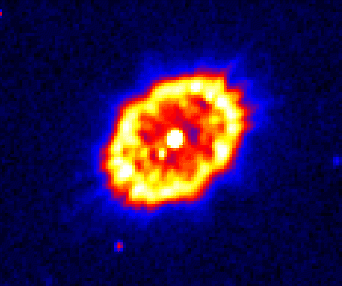
The remnant of nova DQ Her
Credit: Tim O'Brien, WHT
The image at right was taken using the William Herschel Telescope on the island of La Palma. It shows the remnant of a cataclysmic stellar explosion which took place in 1934 in a binary star system known as DQ Herculis. These type of stellar explosions are known as novae since they brighten so much in the explosion that they can appear like new stars in the sky. In fact they result from a thermonuclear explosion on the surface of a white dwarf star in a close binary system. An Earth's mass or more of material is ejected at speeds of up to several thousands of kilometres per second!
Topics to be covered include:
Novae: Classical, recurrent and dwarf.
Supernovae: Type I/II supernovae, explosions of massive stars and of
white dwarf stars.
Microquasars: Ejection of relativistic
jets from binary stars possibly containing black holes.
Gamma-ray bursts: The most powerful explosions in the universe.
Pulsars
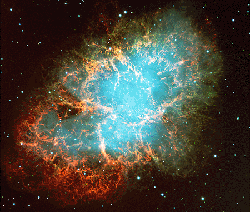
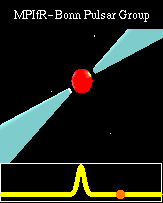
The Crab Nebula and an animation of a pulsar
The animation, created by Michael Kramer, shows the beams of light emitted from the magnetic poles of a spinning neutron star. Such a "pulsar" lies at the heart of the Crab nebula, shown at right in an image from the FORS team at the Very Large Telescope in Chile, the remnant of a supernova explosion observed by Chinese astronomers in the year 1054.
Topics to be covered include:
Properties: Discovery, spin-down, ages, magnetic fields, P-Pdot diagram,
mass, size, structure.
Radio sources: Magnetosphere, emission properties, average & single pulses,
geometry, emission heights, the European Pulsar Network.
The life of pulsars: Evolution in the P-Pdot diagram, their death, reborn pulsars,
millisecond pulsars.
Observations: Instruments, signal to noise, dispersion, dedispersion, timing.
Pulsars as tools: Theories of gravity, cosmology, extrasolar planets,
supernova explosions, interstellar and intracluster medium, extreme solid-state physics.
Finding pulsars: Galactic population, search techniques, parameter space, targeted
searches, acceleration searches & black holes.
Other wavelengths: Optical, X-ray & gamma-ray observations, the future.
Gravitational Lenses
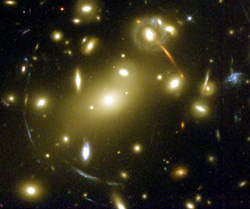
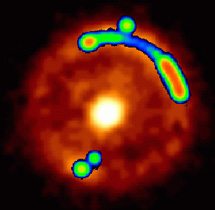
Gravitational lensing
At top right: in this Hubble Space Telescope image the thin arcs are stretched & distorted images of background galaxies which have been gravitationally lensed by galaxies in the foreground cluster Abell 2218. [Credit: Andrew Fruchter, Space Telescope Science Institute].
In the lower image a foreground galaxy acts as a gravitational lens focusing the light from a distant background galaxy B1938+666 into an "Einstein Ring". This is a composite of an infrared image taken with the Hubble Space Telescope (shown in reddish-orange hues) with a MERLIN radio image (in a blue-green-red colour scheme) overlaid. The foreground galaxy shows up in the infrared as the bright spot at the centre of the ring but is not a radio source and so does not appear in the MERLIN image.
Topics to be covered include:
What are they? Basic scheme of a gravitational lens; the lens
equation; deflection angle, odd images, and Fermat's principle; source
and image plane; cuts, caustics, magnification and bias; 2 and 4-image
geometries; mass modelling.
How do we find them? 0957+561, the first lens; early searches; radio
methods; the MG survey; JVAS/CLASS; images of lenses.
What are they good for? Hubble's constant: 0957+561; time
delays; problem of microlensing; other determinations. Cosmological
constant: statistics of lensing; joint constraints of Lambda_0 and
Omega_0. Dark matter: microlensing; MACHO and OGLE; halo objects and
their masses; weak lensing and masses of clusters.
Cosmic Microwave Background

CMB fluctuations
At right is an image of the fluctuations in temperature of the cosmic microwave background made with the Cosmic Background Explorer (COBE) satellite in the early 1990's. These tiny variations are believed to eventually lead to the formation of structures such as clusters of galaxies.
Topics to be covered include:
The Hot Big Bang: Introduction to cosmology, the three pillars
of the big bang - the expanding universe,
the cosmic microwave background (CMB) and cosmological nucleosynthesis.
Observing the CMB: Techniques, instrumentation & results.
Problems with standard cosmology: the expansion problem, the
horizon problem, the structure problem, the antimatter problem. The
inflationary universe, the accelerating universe.
Structure formation: Galaxy clustering, gravitational instability,
primordial fluctuations & dark matter, simulations, using microwave
anisotropies to test cosmological models.
The future: New instruments and prospects for progress.
Entrance qualifications
You need to have already studied a course in introductory astronomy.
This course is taught at the level of 2nd year undergraduate degrees in general science. You must be proficient in the use of the English language, which is the medium of instruction and examination in the University. The minimum acceptable level of proficiency is: GCSE English Language (grade C or above); Cambridge Certificate of Proficiency in English (grade C or above); or an International English Language Testing (IELTS) average score of 6.0. If you have another English language qualification or are proficient but not certified you should contact the Course Director for advice (see address below).
To study at The University of Manchester, you must normally be at least 17 before the degree programme begins and not currently in secondary education. We expect most applicants for this course will be mature students over 21 years of age. Those who have not been involved in academic study for a number of years are welcomed; the course has been designed to encourage and develop the appropriate study skills.
As the course makes extensive use of a personal computer and online materials you will require access to a PC and the internet with a broadband connection.
The Course Director or representative are happy to discuss specific issues relating to any individual's application.
Assessment
Students will be assessed by four pieces of written work (80%) and by a final test to be conducted over the internet (20%). All assessment is delivered and returned via our online learning environment.
A Certificate of Credit for 20 Level 2 credits will be awarded for a final mark of 40% or greater.
The University of Manchester credit system follows the UK national standard in which 120 credits correspond to a year of full-time undergraduate study.
These credits can therefore be transferred to other suitable programmes of study - if you are intending to do this you must first check with the director of the target programme that this course is suitable for accreditation. This does not include the Certificate in Introductory Astronomy offered by the University of Manchester in partnership with the Open University or the Certificate of Higher Education in Astronomy by Distance Learning offered through the astronomy.ac.uk consortium of universities - both these courses are at Level 1 whereas these credits are at Level 2.
Recommended reading
All course notes are provided online so there are no essential purchases. However the following texts are amongst those suitable for students who would like to learn more about the topics covered in this course:
-
Pulsars
Pulsar Astronomy, Lyne & Smith, pub. Cambridge University Press.
At a higher level than this course but very good coverage. -
Gravitational lenses
Gravitational Lenses, Schneider, Ehlers & Falco, pub. Springer.
At a much higher level than this course. -
CMB
3K: The cosmic microwave background radiation, R. B. Partridge, pub. Cambridge University Press, 1995.
Explicitly CMB, obviously does not cover advances of last few years.
Cosmology: the Science of the Universe, Edward R. Harrison, pub. Cambridge University Press, 2000.
Appropriate level for this course, not as much emphasis on CMB.
Cosmological Physics, John Peacock, pub. Cambridge University Press, 1999.
Great coverage of the whole area at a much higher level than this course.
How to contact us
E-mail: Jodrell.Courses@manchester.ac.uk
Jodrell Bank Observatory
School of Physics and Astronomy
The University of Manchester
Macclesfield
Cheshire SK11 9DL
United Kingdom


